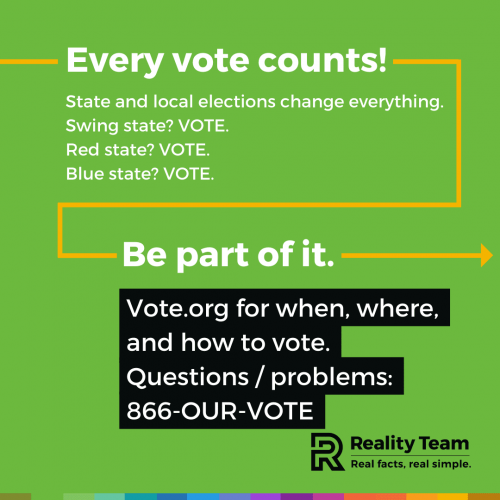It's Election Day - Here's What to Know

- Reality Team
- November 3, 2020
Key takeaways
- Check https://www.vote.org to find your polling place if you don’t know it.
- Every vote matters.
- Voter intimidation is illegal: report it.
- We probably won’t know the results on election night – and that’s normal.
Table of Contents
If you aren't registered to vote
Twenty-one states allow Election Day registration. Go to your polling place in person with proof of address and an ID.
These states are CA, CO, CT, DC, HI, ID, IL, IA, ME, MD, MI, MN, MT, NV, NH, NM, NC, UT, VT, WA, WI, and WY.
Call your local Election Board or visit vote.org for more details.
The 2020 elections will decide the future of local, state and national leadership. In the last 20 years, more than 12 races ended in a tie or were won by one vote. Your vote gives you a say in that future and can make the difference in the election.
Your vote does matter. Local elections choose people for jobs like district attorney that affect communities directly. Voting in this election gives you the chance to take your community in the direction you want.
On Election Day, vote in person, or drop your ballot off at an official location. DO NOT MAIL YOUR BALLOT TODAY. Go to vote.org to find your ballot drop-off locations.
A voting plan will help you get to the polls confident that your vote will be counted. Print this one out, fill in your details, and bring it with you to the polls. It has important numbers you can call if you have questions.
I have a mail ballot that I haven’t returned yet
Visit vote.org or your state’s election page to find out where you can return it in person today. In most states it is TOO LATE to return it by mail. In many states you can vote in person today instead or drop it in a Ballot Dropbox. Please use vote.org or your local election office for the specific rules in your state.
Election day at the polls
What are poll watchers?
Poll watchers monitor the election to make sure it’s being conducted fairly. They report any issues they see to polling place authorities, and their party. They’re not supposed to interfere. Each state has different rules about who can be a poll watcher and how many there can be from each party per polling place. Researchers and nonpartisan representatives of nonprofit organizations and even international observers can also be poll watchers.
Voter intimidation
Voter intimidation is against federal law. It includes trying to get someone to change their vote, or prevent them from voting. It also includes spreading false information about voter requirements. It often targets people of color, or people who are thought to be immigrants. If someone tries to intimidate you from voting, call the Election Protection Hotline (1-866-OUR-VOTE) or the US Department of Justice voting rights hotline (1-800-253-3931) and let your state board of elections know.
Note that some people have been specifically targeted, including black and brown people.
A militia can only be called up by the state or federal government. Anything else is an armed mob with a name. If you see one, it’s probably illegal. Check with local officials, inform your State Board of Elections and call the Election Protection Hotline:
- English: 1-866-Our-Vote
- Spanish: 1-888-Ve-Y-Vota
- Asian and Pacific Islander: 888-API-Vote
- Call the US Department of Justice voting rights hotline: 1-800-253-3931
Voting by mail has a long history and states have safeguards to protect it. Some of these include a signature verification process, unique bar codes on ballots, ballot tracking systems. States also use physical security measures like 24-hour surveillance of ballot dropboxes, and clear chain of custody for the ballots. Vote by mail is a secure and safe way to run an election.
Vote by mail is secure, valid and safe
There’s a lot of disinformation about mail-in ballots – but be confident. Voting by mail is secure, tracked and backed by years of experience. Be confident – mail in ballots and absentee ballots will be counted and people will have their votes counted.
Voting ends November 3. Most states accept and count ballots postmarked by November 3 be counted even if they arrive several days later. We will probably have a solid idea of the winner this week, but states don’t have to finalize their results till December 8 – a date set by federal law.
References
If you’d like to fact check this piece or learn more about these topics, these are the references we used to put this explainer together.
National Conference of State Legislatures: Same Day Voter Registration
NPR: Why Every Vote Matters — The Elections Decided By A Single Vote (Or A Little More)
National Conference of State Legislatures: Absentee and Mail Voting Policies in Effect for the 2020 Election
c|net: Yes, voter intimidation at the polls is illegal. Here’s what to do about it
National Association of Secretaries of State: State laws poll watchers challengers Jan2020
Georgetown Law, Institute for Constitutional Advocacy and Protection: Fact Sheets on Unlawful Militias for All 50 States Now Available from Georgetown Law’s Institute for Constitutional Advocacy and Protection
c|net: How do I track my ballot online? Here’s how for every state
Congressional Research Service: The Electoral College: A 2020 Presidential Election Timeline
See an error in our work? Please let us know and include the source of your info. We’ll update or correct as appropriate.
Search
Get Reality in Your Inbox
Most states have ballot tracking so you can see the status of your ballot. Some states will give you the chance to correct your ballot if it gets rejected because the signature doesn’t match or if it wasn’t signed. Here’s how you can track it in your state.
